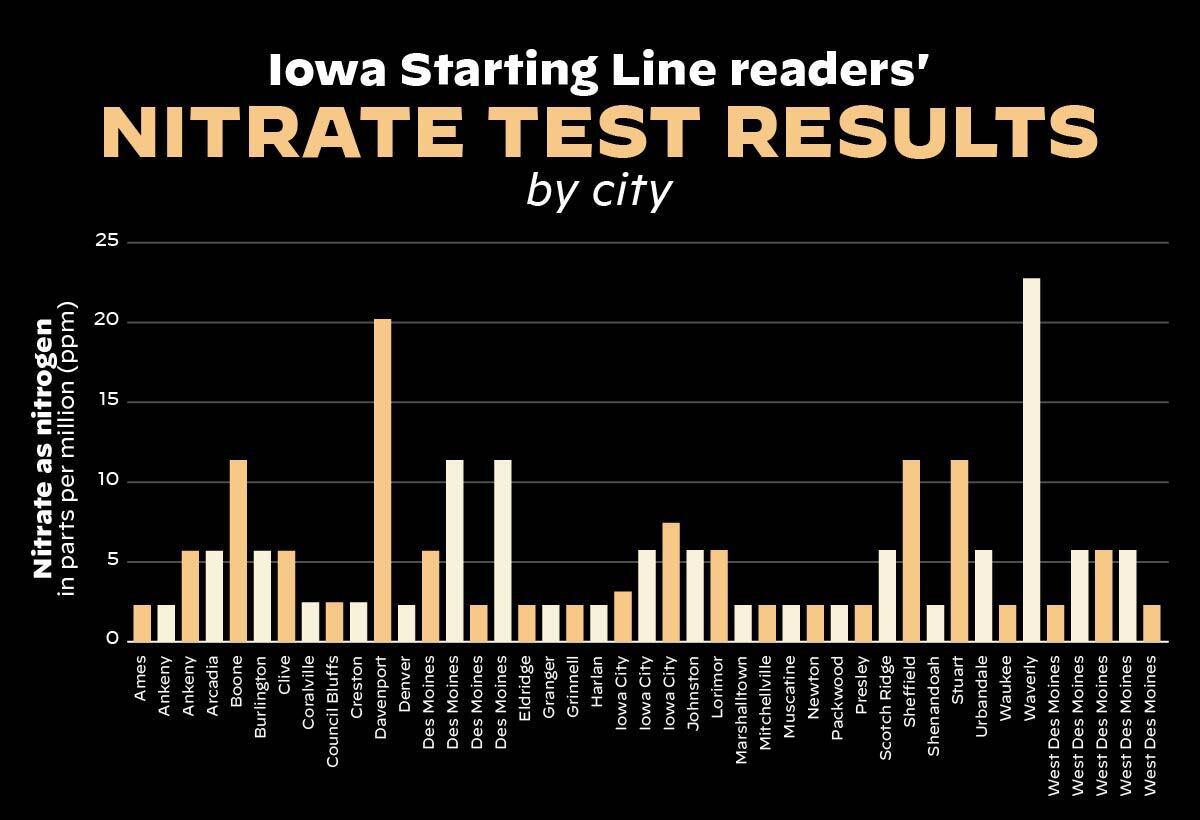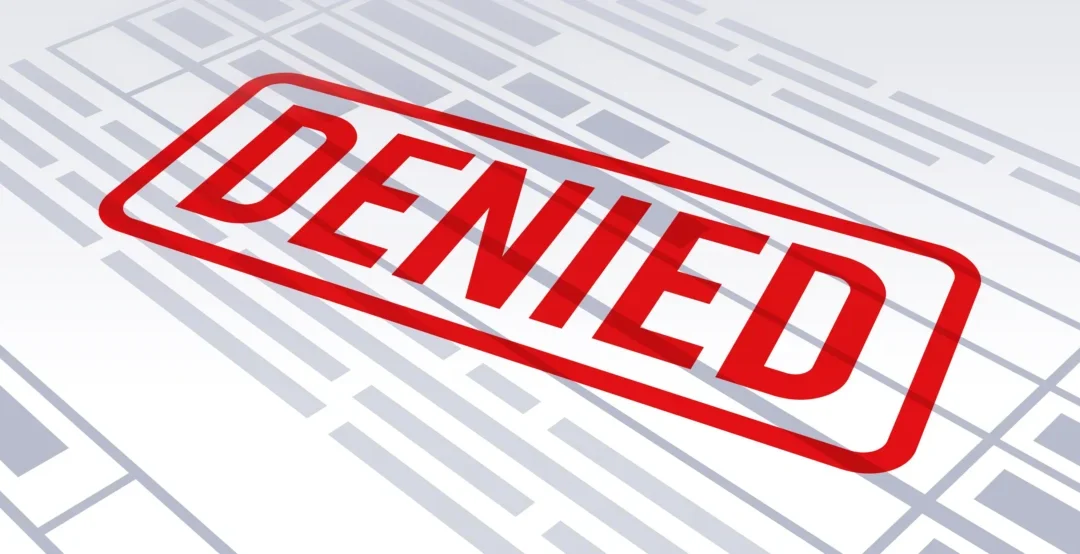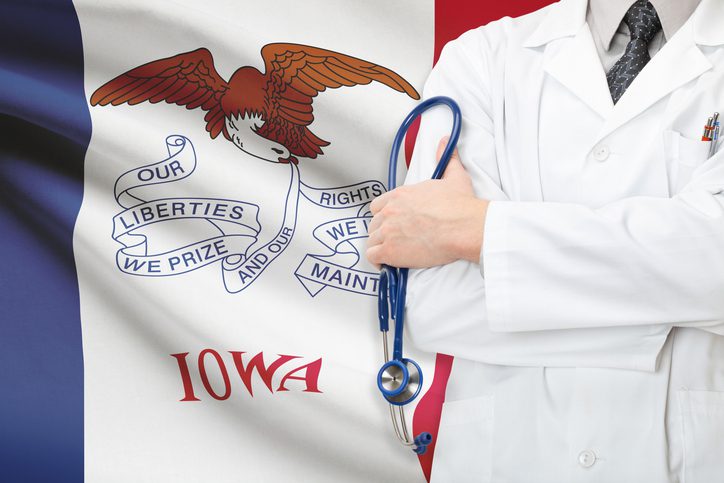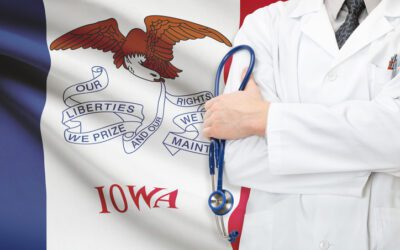
(Francesca Daly/Iowa Starting Line)
This story first appeared in the Sept. 30 edition of the Iowa Starting Line newsletter. Subscribe to our newsletter to get an exclusive first look at a new story each Tuesday in our The Hot Spot: Investigating Cancer in Iowa series.
We sent out 100 tests to Iowans across the state, who found nitrate levels that exceeded safety guidelines. Experts say these levels may increase cancer risk.
I’d been measuring my nitrate test results all wrong. Chris Jones, a former lab scientist at Des Moines Water Works, confirmed it.
During the summer, I sent out nearly 100 nitrate test strips to Iowans across the state. Over half returned those strips back to me—not bad!
Sometimes the photos weren’t perfectly clear; people occasionally emailed me the “nitrite” number instead, and I had to rely on my eyes. But the bigger issue was that the numbers on those test strips don’t match how the Environmental Protection Agency (EPA) and water treatment plants count nitrates.
“The convention in the United States [is], we regulate nitrate as nitrogen,” Jones said.
Without getting too deep in the chemistry, that basically means I have to divide all the results our readers sent in by 4.4. (Why Europe and the US can’t agree on how to measure this is beyond me.)
Our experiment, which we launched after publishing our report on the relationship between Iowa’s water quality and rising cancer rates, includes results from cities across the state. Interestingly, we had a cluster of tests from Central Iowa, where Water Works has had problems with nitrate contamination in recent years.
What the reader-submitted water tests show is a wide range of nitrate levels, depending on where you live.
Reading the nitrate test results
The EPA is in charge (as of this writing) of regulating nitrates in the nation’s water. It has set the “maximum contaminant level” of 10 parts per million, or ppm, in order to prevent blue baby syndrome.
Anything over 3, however, will “generally indicate contamination,” the EPA also notes. And, as I’ve previously reported, nitrate contamination is associated with cancer.
Expressed in nitrate-as-nitrogen, a result of 10 ppm on the test strips we sent out would actually only be 2.3 ppm, and a result of 25 would be 5.7, which is considered contaminated. Anything over 44 ppm on that test is officially over the maximum.
But picking out that result—is it light pink, or slightly darker pink?—isn’t an exact science.
“I have to say it’s really hard to tell!” Julie Santee of Shenandoah told us via email after testing her water.
Alex Hammer sent us a video of his test results from the township of Scotch Ridge in rural Warren County, just south of Des Moines. The results (correctly calculated) showed a nitrate level from his city water of “at least” 5-6 ppm, over the EPA’s level of contamination.
“So that’s cool,” Hammer says sarcastically in the video.
But, he added, he was grateful someone was reporting on it. “Thanks for making this central to what people are talking about. Appreciate it as a colon cancer survivor. Keep up the good work.”
Mike Stein of Iowa City already filters his water through a reverse osmosis system, which removes nitrates. He recorded testing his unfiltered tap water on camera on different dates between July and September, and found levels up to 7.5 ppm, which he considered good news: “Nitrate levels seem to be coming down in the Iowa River a bit,” he said.
Overall, results averaged 3.3 ppm—showing contamination—across all results that came back. These are, of course, only a snapshot in time of what the drinking water was like the day of testing, so take these results with that grain of salt.

Confirming Central Iowa’s nitrate problem
The data around Central Iowa cities didn’t surprise Jones, the former Des Moines Water Works employee, considering what he knows about its troubles with nitrate this year.
“Certainly this year, a result around 10 milligram per liters as nitrogen—which would be 44 or you know, around 50 [on the test strip]—would’ve been very common in Polk County,” Jones said. “And it would’ve been common for Iowa City, and it would’ve been common for Cedar Rapids.”
A couple tests in our experiment registered quite high—a few near 44, with two even looking to be more than 50 (I’ve removed those from the chart). Any one number could be suspect, Jones said, but taken together, a data set like this could be useful.
”What is the story here?” Jones said. “I would say, for Des Moines, your people are confirming that the nitrate was high.”
Each year, water treatment plants put out a public report that includes levels of many types of contaminants, including nitrate. Jones finds it useful to compare those results to at-home tests.
“Like Shenandoah, for example, and find their water quality report for 2024 and see what the nitrate was in 2024 and years prior to that,” he said. “See if it jives.”
Cities without demonstrated nitrate problems only have to test monthly, but others—like Des Moines, where the watershed has had nitrate problems frequently—are sometimes monitored daily when they’re using nitrate removal equipment.
Solutions for safer tap water
Jones recently published a list of 28 policy ideas he thinks the Iowa Legislature could enact to fix Iowa’s water quality problems.
But there’s two big ones he has in mind. The first: Get Iowa farmers out of the monoculture life.
“ The main thing, if we want better environmental outcomes, we need a more diverse farming system; that’s bottom line,” he said.
The second: Actual regulations around water pollution.
“This approach of going around the state and sprinkling a million dollars here and a million dollars there makes for good news, but it’s not any sort of strategy that’s gonna improve water quality in any reasonable length of time,” he said.
Until that happens, Jones got himself a reverse osmosis system for his home’s drinking water, and begrudgingly advises the same for Iowans similarly worried about their high test results.
“Especially when I worked at Des Moines Water Works, I used to get questions all the time: Should I drink bottled water or should I get a home treatment device? And quite often I would discourage both of those things for a variety of reasons,” Jones said.
But he caved this year, installing a system on his cold tap water.
“I said, ‘I’ve seen enough,’” he said. “I think the evidence is strong that drinking water above three milligrams per liter, nitrate-as-nitrogen, presents an unnecessary health risk to adults, especially women.”
Support Our Cause
Thank you for taking the time to read our work. Before you go, we hope you'll consider supporting our values-driven journalism, which has always strived to make clear what's really at stake for Iowans and our future.
Since day one, our goal here at Iowa Starting Line has always been to empower people across the state with fact-based news and information. We believe that when people are armed with knowledge about what's happening in their local, state, and federal governments—including who is working on their behalf and who is actively trying to block efforts aimed at improving the daily lives of Iowan families—they will be inspired to become civically engaged.


Surviving cancer in Iowa: Caregivers, advocates share their stories
Cancer in Iowa isn’t just about the research studies and the statistics. Real Iowans and their families are behind each diagnosis. Read our first...

How can policymakers help reduce Iowa’s cancer rates?
This story first appeared in the Sept. 23 edition of the Iowa Starting Line newsletter. Subscribe to our newsletter to get an exclusive first look...

Fighting a health insurance denial? Here are 7 tips to help
By: Lauren Sausser When Sally Nix found out that her health insurance company wouldn’t pay for an expensive, doctor-recommended treatment to ease...

Iowa leads the nation in binge drinking—and faces higher cancer risks from alcohol
This story first appeared in the Sept. 16 edition of the Iowa Starting Line newsletter. Subscribe to our newsletter to get an exclusive first look...

What you can do to reduce your cancer risk: The big six for Iowans
A version of this story first appeared in the Sept. 9 edition of the Iowa Starting Line newsletter. Subscribe to our newsletter to get an exclusive...

OPINION: As a future pediatrician, I shouldn’t be preparing for diseases from the past
As an Iowan, I've always been drawn to helping people. Growing up “Iowa nice” transformed into a desire to become a pediatrician, connecting with...






